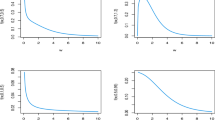Abstract
In this paper we introduce a new discrete time and continuous state space stationary process {Xn;n = 1,2,…}, such that Xn follows a two-parameter generalized exponential (GE) distribution. Joint distribution functions, characterization and some dependency properties of this new process have been investigated. The GE-process has three unknown parameters, two shape parameters and one scale parameter, and due to this reason it is more flexible than the existing exponential process. In presence of the scale parameter, if the two shape parameters are equal, then the maximum likelihood estimators of the unknown parameters can be obtained by solving one non-linear equation and if the two shape parameters are arbitrary, then the maximum likelihood estimators can be obtained by solving a two dimensional optimization problem. Two synthetic data sets, and one real gold-price data set have been analyzed to see the performance of the proposed model in practice. Finally some generalizations have been indicated.







Similar content being viewed by others
References
Al-Hussaini, E.K. and Ahsanullah, M. (2015). Exponentiated Distributions. Atlantis Press, France.
Arnold, B.C. (1993). Logistic process involving Markovian minimization. Communications in Statistics - Theory and Methods 22, 1699–1707.
Arnold, B.C. (2001). Pareto process, Handbook of Statistics, 19. Elsevier, Amsterdam, Rao, C. R. and Shanbag, D. N. (eds.), p. 1–33.
Arnold, B.C. and Hallet, T.J. (1989). A characterization of the Pareto process among stationary processes of the form \(X_{n}, = c \min \limits (X_{n-1}, Y_{n})\). Stat. Probab. Lett. 8, 377–380.
Bemis, B., Bain, L.J. and Higgins, J.J. (1972). Estimation and hypothesis testing for the parameters of a bivariate exponential distribution. J. Amer. Stat. Assoc. 67, 927–929.
Granger, C.W.J. and Andersen, A.P. (1978). An introduction to bilinear time series models. Angewandte Statistik und Okonometrie, Heft 8. Vandenhoeck & Ruprecht, Gottingen 94.
Gupta, R.D. and Kundu, D. (1999). Generalized exponential distribution. Austral. Zealand J. Stat. 41, 173–188.
Gupta, R.D. and Kundu, D. (2007). Generalized exponential distribution: Existing methods and recent developments. J. Stat. Plann. Infer. 137, 3537–3547.
Halmos, P.R. (1950). Measure Theory,. D. Van Nostrand Company Inc, New York.
Jayakumar, K. and Girish Babu, M. (2015). Some generalizations of Weibull distribution and related processes. J. Stat. Theor. Appl. 14, 425–434.
Jose, K.K., Ristić, M.M. and Joseph, A. (2011). Marshall-Olkin bivariate Weibull distributions and processes. Stat. Papers 52, 789–798.
Kundu, D. and Gupta, R.D. (2009). Bivariate generalized exponential distribution. J. Multivar. Anal. 100, 581–593.
Kundu, D. and Gupta, R.D. (2010). A class of bivariate models with proportional reversed hazard marginals. Sankhya, Ser. B 72, 236–253.
Mudholkar, G.S. and Srivastava, D.K. (1993). Exponentiated Weibull family for analyzing bathtub failure data. IEEE Trans. Reliab. 42, 299–302.
Nadarajah, S. (2011). The exponentiated exponential distribution; A survey. Adv. Stat. Anal. 95, 219–251.
Nelsen, R.B. (2006). An Introduction to Copulas, 2nd edn. Springer, New York.
Nelson (1976). The Use of Box-Cox Transformation in Econometric Time Series: An Empirical Study, Ph.D. Thesis Economics Department. The University of California, San Diego.
Pillai, R.N. (1991). Semi-pareto processes. J. Appl. Probab. 28, 461–465.
Sim, C.-H. (1986). Simulation of Weibull and gamma autoregressive stationary process. Commun. Stat. Simul. Comput. 15, 1141–1146.
Tavares, L.V. (1980). An exponential Markovian stationary process. J. Appl. Probab. 17, 1117–1120.
Weiss, G. (1975). Time reversibility of linear stochastic process. J. Appl. Probab. 12, 143–171.
Acknowledgments
The authors would like to thank the unknown reviewers for making constructive suggestions which have helped to improve the earlier version of the manuscript significantly.
Author information
Authors and Affiliations
Corresponding author
Ethics declarations
Conflict of Interests
It is to declare that the I do not have any conflict of interest, and did not receive any financial support for this project.
Additional information
Publisher’s Note
Springer Nature remains neutral with regard to jurisdictional claims in published maps and institutional affiliations.
Rights and permissions
About this article
Cite this article
Kundu, D. Stationary GE-Process and its Application in Analyzing Gold Price Data. Sankhya B 84, 575–595 (2022). https://doi.org/10.1007/s13571-021-00272-z
Received:
Accepted:
Published:
Issue Date:
DOI: https://doi.org/10.1007/s13571-021-00272-z
Keywords
- Generalized exponential distribution
- maximum likelihood estimators
- minification process
- maxification process.




